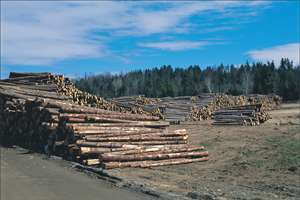Imagine yourself driving into a North Country town one afternoon and finding a business there that employed 92,771 people and turned out $14.4 billion in manufactured products. You’d probably ask yourself, “Who are these guys? And how come I’ve never heard of them before?
The company in question is actually an aggregation of companies – collectively known as the forest-products industry – and the reason you’ve never driven into a small town and seen it is that the people and revenues are spread out across New York, Vermont, New Hampshire, and Maine. With a logger here and a trucking company there, a paper mill here and a furniture maker there, these people and jobs are never assembled in one place – not even at a trade show. And that’s why it’s easy to miss the economic significance of all these businesses and value-added products.
These and other numbers come from a recent series of reports by the North East State Foresters Association (NEFA), a collaboration of the state foresters in each of the four states working together with researchers from the U.S. Forest Service and partners in private industry.
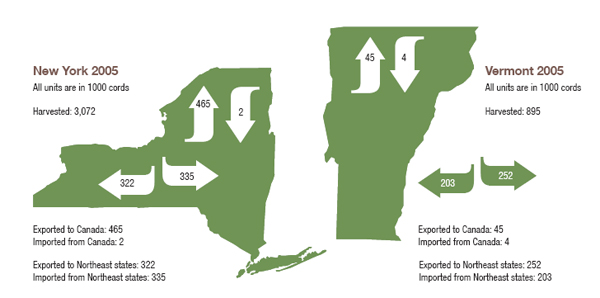
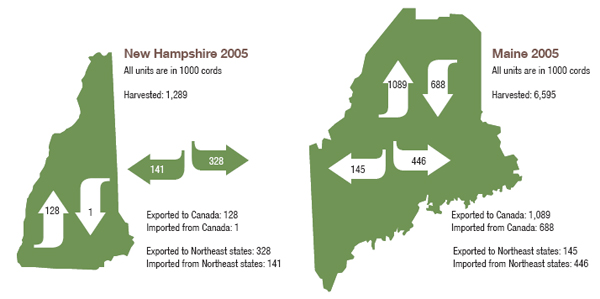
The Economic Importance and Wood Flows from the Forests of Maine, New Hampshire, Vermont, and New York, 2007 paints a detailed portrait of our forests. In addition to the 92,771 people and $14.4 billion in wood-based manufacturing, the report finds another 44,400 people and $3.4 billion involved in recreation and tourism directly related to our forests. Average annual wages of $36,649 in the manufacturing sector are more than twice the $16,081 averaged by people working in recreation and tourism.
Landowners in the four-state region sold standing timber that brought them $557 million. Meanwhile, total sales of specialty products such as wreaths, Christmas trees, and maple syrup added up to $66 million.
The report also looks at where trees are being cut and where they’re being processed. Maine leads the region by cutting 57 percent of the wood and supplying 59 percent of the processing in the four-state region. New York is next at 27 percent of the wood and 22 percent of the processing. New Hampshire and Vermont are tied at 8 percent of the wood, with New Hampshire at 11 percent of the processing and Vermont at 8 percent.
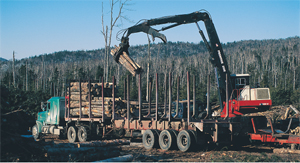
Canada also plays a prominent role in the figures. Of the 11.5 million cords of wood cut in the region (all wood, including sawlogs, veneer, and biomass, is calibrated in cords), 1.7 million are exported to Canada. Since 695,000 cords flow back across the border the other way, Canada ends up being a net importer of about 9 percent of the total harvest from the four states.
These figures are based on data that have been several years in the collecting, however, and the latest numbers indicate a drop in foreign exports. “In New York, we saw a 20 percent drop in wood exports in 2006,” said Sloane Crawford, of the New York State Department of Environmental Conservation – Forest Products Utilization Program. “And 2005 was down from 2004.”
Though a strengthening Canadian dollar should theoretically be increasing exports to Canada, the decline is the result of the overall cooling of the economy. “Flooring mills in Quebec are a significant buyer of our wood,” adds Crawford, “and the slowdown in housing has cut into their production.”
Wood that isn’t flowing north across the border from the four states is likely heading east into Maine, which is the only state of the four that is a major importer of wood due to the inflow of pulpwood (for the pulp and paper industry) and biomass chips (for energy) from Canada, New Hampshire, and Vermont. Nevertheless, your typical tree is most likely to be processed within the state where it was cut; exports from each state amount to only 20 percent of the total harvest.
The NEFA researchers further dissect the total wood harvest into the following categories: hardwood logs, softwood logs, hardwood pulp, softwood pulp, residential fuelwood, and biomass chips. From these categories, more observations emerge.
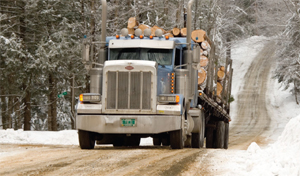
New York is a hardwood state, with the combined harvest of hardwood sawlogs and pulpwood more than double the comparable harvest of softwood. About a third of all sawlogs are exported, primarily to Canada. Pulpwood is the largest import, feeding the state’s two remaining pulp mills, especially now that pulp processing has been reduced elsewhere in the region. New York is currently a net exporter of biomass chips, though that could be changing, as a new pellet-fuel plant has opened in the state and there has been renewed interest in building more biomass electricity plants, especially at the community level.
In Vermont, the primary use of wood is for heat and electricity; a residential woodstove is the most likely destination for any hardwood tree cut in the state. Biomass chips flow in from out of state, meanwhile, because the two main chip-burning power plants are located on the borders with New York and New Hampshire. In addition to the big biomass plants, Vermont has more than 50 small-scale users of biomass chips, notably school buildings, making it the state with the largest number of biomass facilities.
In New Hampshire, a dramatic shift is underway as pulp and paper give way to biomass energy. Though the NEFA numbers don’t yet fully account for these changes, the closure of the state’s last pulp mill means that the state’s pulpwood is now being shipped to Maine, Canada, or New York for processing into pulp, usually after having been debarked and chipped locally. The state’s remaining paper mill, in Gorham, ends up importing pulp from elsewhere. Meanwhile, the new 50-megawatt biomass energy plant in Portsmouth is taking up some of the slack in the low-grade wood market, though drawing largely from a different part of the state. Of the $150 million dollars in value and 1.2 million cords of processing lost by the closure of the Berlin pulp mill, the new biomass plant is replacing $30 million in manufactured value and 500,000 cords of wood use.
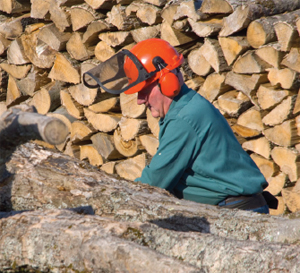
Maine, though a net importer of wood overall, sends a third of its sawlogs out of state for processing, primarily to Canada. The account balance is restored by the inflow of hardwood pulp, softwood pulp, and biomass chips, roughly 40 percent from the other northeastern states and 60 percent from Canada. Another interesting statistic about Maine: seven million acres, or roughly 40 percent of the timberland in the state, is green-certified – either through the Sustainable Forestry Initiative (SFI) or the Forest Stewardship Council (FSC) – by far the most of any northeastern state.
Finally, the NEFA report highlights a statistic that few of us keep in mind on a daily basis: each 1,000 acres of forestland in the four-state region directly supports 1.9 jobs, either in forest-based manufacturing, tourism, or recreation. Since the vast majority of these acres are privately owned (federal, state, and local governments own just over 11 percent of the timberland in the four states), this means that the future of forestry and forest management in the Northeast lies in the hands of the many thousands of families and individuals who own land in the region. It’s easy to overlook the sheer number and importance of these people since, like the mythical North Country factory that employs 92,771 people, they’re never gathered together in one place.


